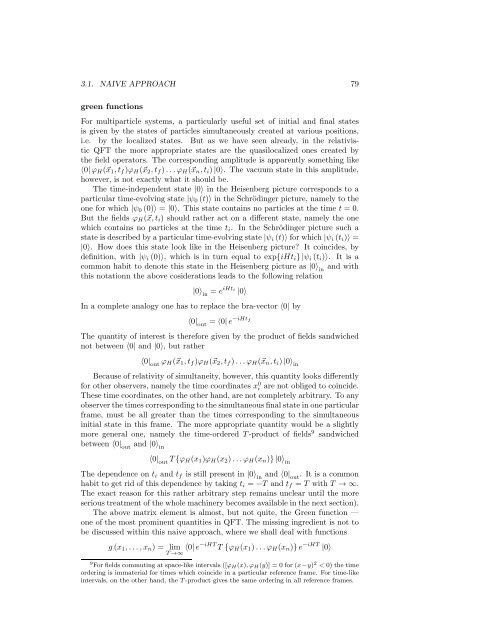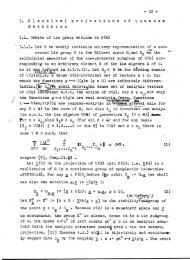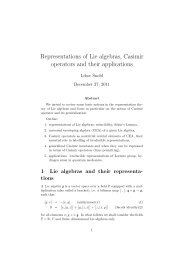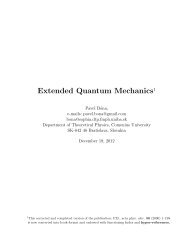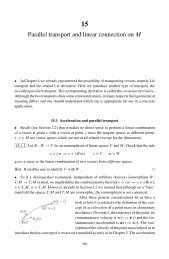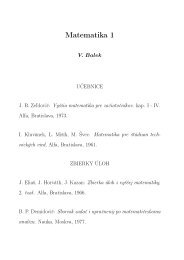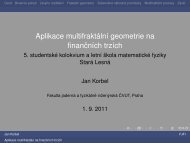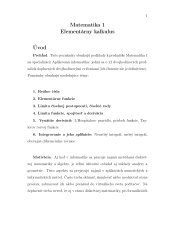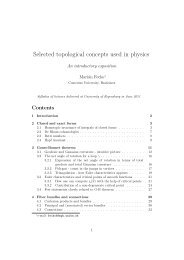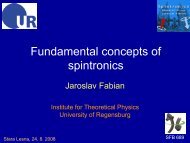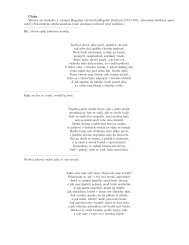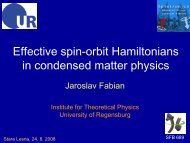Quantum Field Theory I
Quantum Field Theory I
Quantum Field Theory I
Create successful ePaper yourself
Turn your PDF publications into a flip-book with our unique Google optimized e-Paper software.
3.1. NAIVE APPROACH 79<br />
green functions<br />
For multiparticle systems, a particularly useful set of initial and final states<br />
is given by the states of particles simultaneously created at various positions,<br />
i.e. by the localized states. But as we have seen already, in the relativistic<br />
QFT the more appropriate states are the quasilocalized ones created by<br />
the field operators. The corresponding amplitude is apparently something like<br />
〈0|ϕ H (⃗x 1 ,t f )ϕ H (⃗x 2 ,t f )...ϕ H (⃗x n ,t i )|0〉. The vacuum state in this amplitude,<br />
however, is not exactly what it should be.<br />
The time-independent state |0〉 in the Heisenberg picture corresponds to a<br />
particular time-evolving state |ψ 0 (t)〉 in the Schrödinger picture, namely to the<br />
one for which |ψ 0 (0)〉 = |0〉. This state contains no particles at the time t = 0.<br />
But the fields ϕ H (⃗x,t i ) should rather act on a different state, namely the one<br />
which contains no particles at the time t i . In the Schrödinger picture such a<br />
state is described byaparticulartime-evolvingstate|ψ i (t)〉 forwhich |ψ i (t i )〉 =<br />
|0〉. How does this state look like in the Heisenberg picture It coincides, by<br />
definition, with |ψ i (0)〉, which is in turn equal to exp{iHt i }|ψ i (t i )〉. It is a<br />
common habit to denote this state in the Heisenberg picture as |0〉 in<br />
and with<br />
this notationn the above cosiderations leads to the following relation<br />
|0〉 in<br />
= e iHti |0〉<br />
In a complete analogy one has to replace the bra-vector 〈0| by<br />
〈0| out<br />
= 〈0|e −iHt f<br />
The quantity of interest is therefore given by the product of fields sandwiched<br />
not between 〈0| and |0〉, but rather<br />
〈0| out<br />
ϕ H (⃗x 1 ,t f )ϕ H (⃗x 2 ,t f )...ϕ H (⃗x n ,t i )|0〉 in<br />
Because of relativity of simultaneity, however, this quantity looks differently<br />
for other observers, namely the time coordinates x 0 i are not obliged to coincide.<br />
These time coordinates, on the other hand, are not completely arbitrary. To any<br />
observerthetimescorrespondingtothesimultaneousfinalstateinoneparticular<br />
frame, must be all greater than the times corresponding to the simultaneous<br />
initial state in this frame. The more appropriate quantity would be a slightly<br />
more general one, namely the time-ordered T-product of fields 9 sandwiched<br />
between 〈0| out<br />
and |0〉 in<br />
〈0| out<br />
T{ϕ H (x 1 )ϕ H (x 2 )...ϕ H (x n )}|0〉 in<br />
The dependence on t i and t f is still present in |0〉 in<br />
and 〈0| out<br />
. It is a common<br />
habit to get rid of this dependence by taking t i = −T and t f = T with T → ∞.<br />
The exact reason for this rather arbitrary step remains unclear until the more<br />
serioustreatment ofthe wholemachinerybecomes availablein the next section).<br />
The above matrix element is almost, but not quite, the Green function —<br />
one of the most prominent quantities in QFT. The missing ingredient is not to<br />
be discussed within this naive approach, where we shall deal with functions<br />
g(x 1 ,...,x n ) = lim<br />
T→∞ 〈0|e−iHT T {ϕ H (x 1 )...ϕ H (x n )}e −iHT |0〉<br />
9 For fields commuting at space-like intervals ([ϕ H (x),ϕ H (y)] = 0 for (x−y) 2 < 0) the time<br />
ordering is immaterial for times which coincide in a particular reference frame. For time-like<br />
intervals, on the other hand, the T-product gives the same ordering in all reference frames.


